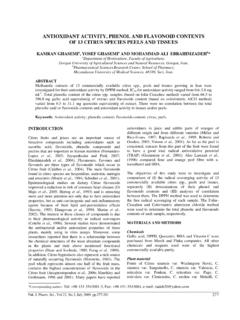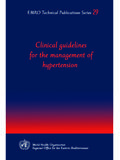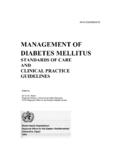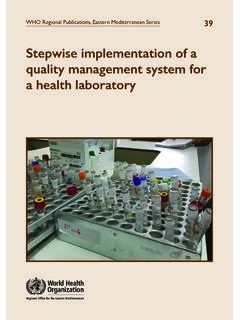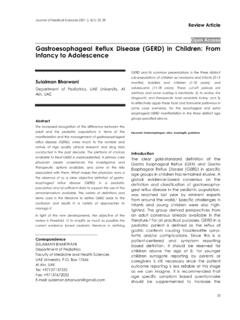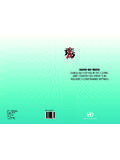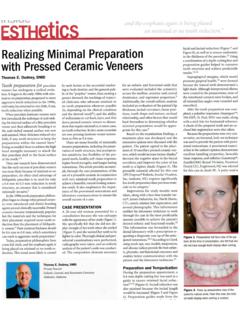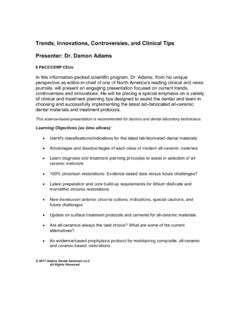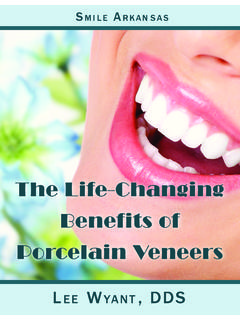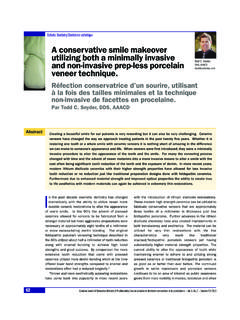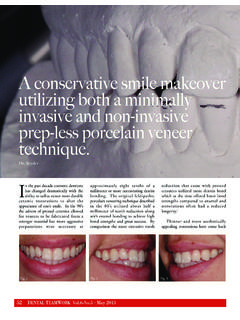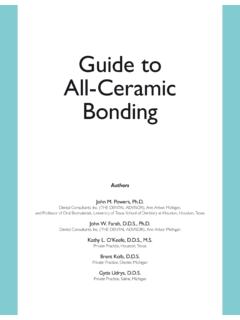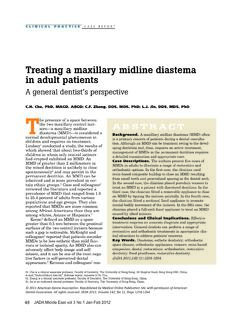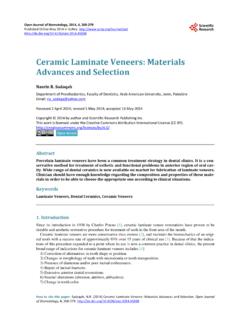Transcription of The Gold Standard in Adhesive Esthetic Dentistry: Ceramic ...
1 | 26 | Smile Dental Journal | Volume 7, Issue 1 - 2012 ABSTRACTThe two revolutions that have changed the face of Dentistry in the past few decades is Bonding and Dental increasing desire for our clients to look better and have more confidence is making them choose elective treatment in order to achieve better and more pleasing are perhaps the biggest contrast on the human body and any striking disharmony is quite veneers have become a very popular choice for the patient as well as the dentist to provide the clients with dynamic harmony in their this presentation an attempt is made to briefly look at the past and to have a detailed prespective about
2 Different methods to fabricate Ceramic case presentations will highlight the gold Standard in fabrication of veneers which integrate with the soft and hard oral tissues harmonizing with the personality and character of an individual. KEYWORDSV eneers, Creation-Willi Geller Ceramic , Gold Standard in Adhesive Esthetic Dentistry: Ceramic Veneers from 1930 to NOWL amberto Villani MDT Oral Design Dubai - UAE - Juneja MDSP rosthodontics, Dental Studio, Dubai - UAEINTRODUCTIONThe use of veneers in dentistry is not a new the early 1930 s, the appearance of picture perfect teeth on the screen was due to Dr. Charles Pincus pioneering work with porcelain laminates.
3 He was founder and first president of the American Academy of Aesthetic Dentistry. He published numerous articles and was a contributor to Dr. Ronald Goldstein s book on aesthetic dentistry. At that time, they fell off in a very short time as they were held on by denture Adhesive . They were, however, useful for temporarily changing the smile of the Hollywood stars were working in front of the camera or making personal appearances. Since they were basically experimental, patients were instructed not to eat when wearing them. Later on, acrylic was adopted. He fabricated these veneers by baking a thin layer of porcelain onto platinum roots of modern concepts of veneering began over half a century ago.
4 In 1955, Bounocore spoke of bonding. In the 1960s Bowen and others developed composite resin restorations. In 1972, Dr. Alain Rochette published a paper describing acid etch bonding of porcelain to enamel. The porcelain itself was not etched, but was pre-treated with a coupling agent to promote chemical adhesion of an unfilled resin luting nothing more was heard of this technique for a decade as the interest of the dental profession was focused on improving the composite resin materials used for direct application to the etched started in 1982 by Simonsen and Calamia4 revealed that porcelain could be etched with hydrofluoric acid, and bond strengths could be achieved between composite resins and porcelain that were predicted to be able to hold porcelain veneers on to the surface of a tooth permanently.
5 This was confirmed by Calamia5 in an article describing a technique for fabrication, and placement of Etched Bonded porcelain Veneers using a refractory model technique and Horn6 describing a platinum foil technique for veneer fabrication. Additional articles have proven the long-term reliability of this veneers are more durable and less likely to stain than veneers made of OF VENEERSM inimally invasive procedure: Ceramic veneers in the right indication can change the apprearance of the teeth and the smile with minimal or almost no alteration of natural tooth tissues. Veneers can be thinned down to and this makes it possible to preserve natural tooth structure where as the traditional crowns required quite aggressive tooth Dental Journal | Volume 7, Issue 1 - 2012 | 27 |Excellent Biological Response: Ceramic as a material is known to have the best biologial response around it.
6 It is a crystalline glass and has minimal or no tendency to get scratched or have surface alterations over the years, thereby keeping the colour and tissue integrity over the ,19An increase in crevicular fluid: It is known to stimulate the gingival tissue and improve circulation around well fitting margins. This leads to an increase in crevicular fluid, which in turn leads to less plaque fluorescence: Under exposure to ultraviolet, natural teeth emit a light blue fluorescence which also enhances the whiteness and brightness of teeth in daylight. Different chemical activators are added in commercial dental ceramics to present the fluorescence which can act as natural teeth in color and intensity under exposure of sunlight or artificial ultraviolet illumination.
7 Over the years ceramics have been developed for them to have natural fluorescence to mimic the optical properties of the Dentine. If this is not present in a restorative material then the restorations can look lifeless in certain light conditions. INDICATIONS Diastemas closure Tetracycline discoloration Crowded teeth Fractured teeth Gummy smile To change the shape of the teeth : MicrodontiaCONTRAINDICATIONS Deep bite Less than 50% of the bonding surface is enamel Patients with known history of parafunction and having damaged similar restorations in the past Highly Flourosed teethDIFFERENT SYSTEMSCast glass- Ceramic (Dicor)The Dicor crown system uses the lost wax system to produce a glass casting of the restoration.
8 Were first introduced for all- Ceramic crowns. The material exhibits interesting physical and chemical properties, but the high fabrication costs and restricted esthetics have limited further development of this Ceramic (Empress, Impulse, Creation etc.)Offers two elaboration modalities:The reinforced pressed porcelain is used to fabricate either an entire restoration or only a core. This latter option allows Esthetic improvements and characterization by additional Ceramic firing. Esthetic characterization, however, remains very limited compared to the full-thickness layering that can be applied with the refractory die casting (In-Ceram Spinell)Can generate restorations with higher intrinsic strength compared to other systems.
9 The basic method was originally marketed for full crowns and later adapted to veneers with the use of spinel instead of alumina. Due to the high crystalline content of this material, traditional hydrofluoric acid etching is not effective. Resin bonding to In-Ceram alumina, for instance, requires tribochemical silica coating or use of a special resin Ceramic (Cerec)Even though originally designed for chairside use, have become popular laboratory use also. Veneers made from machined Ceramic suffer from shade uniformity and rather simplistic anatomy, unless additional porcelain firings are carried die techniqueCeramic fired over refractory die is the oldest and the most widespread method for fabricating a porcelain object.
10 The main advantages of this technique are: No special equipment required Extremely sophisticated effects of color and translucency can be obtained through a full-thickness layering technique Traditional feldsphatic porcelains can be used when combined with hydrofluoric acid etching and silanization, they show extremely reliable bonding to resins Marginal closure from 20 to 40 m CASE 1 Courtesy of Dr. Rabih Abi NaderThis is a case where the patient was unhappy with the shape and colour of her teeth. (Fig 1)After critical evaluation it was planned that 4 veneers for teeth 22, 21, 11 and 12 should be a good treatment option.
